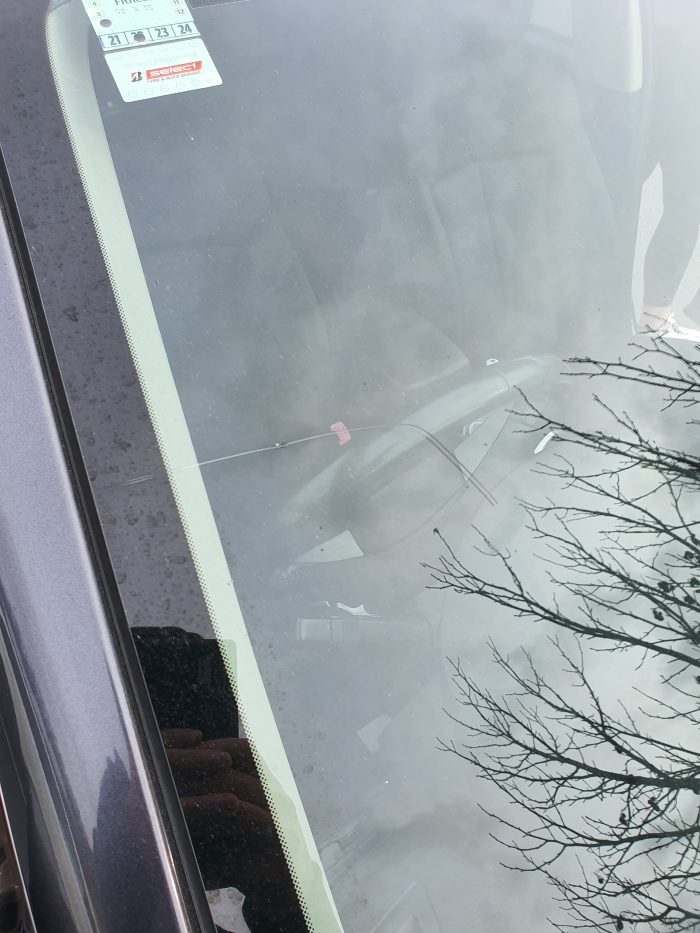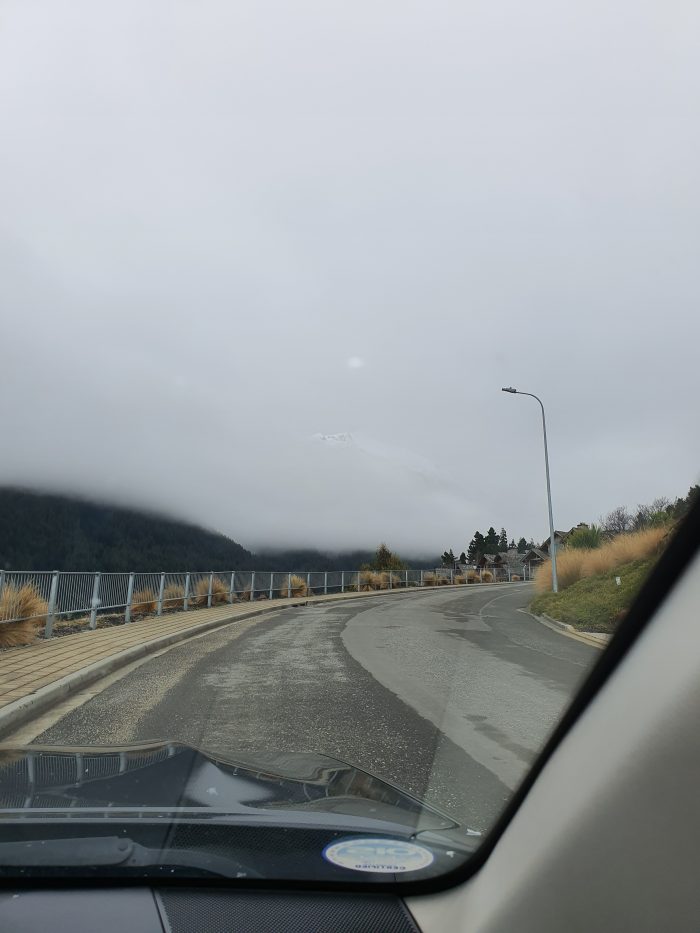Few things in life are as annoying as someone else putting a chip or crack in your car windshield. Despite driving well yourself, you can still fall victim to someone else flicking up a stone or other debris and damaging your windshield.
This recently happened to me on a trip to Queenstown, New Zealand (a town famous for its scenery and plethora of ‘adrenaline-junkie’ activities e.g. bungee jumping, skiing/snowboarding, canyon jetboating etc).
I was driving my Subaru Legacy wagon from the town of Wanaka – where I had been staying to do some skiing – across the Crown Range road (aka “Crown Ranges”). This is a twisty piece of road that effectively provides a shortcut over the mountains that separate Wanaka from Queenstown. It is also the highest piece of road in New Zealand.

The Crown Range road is notorious for challenging weather conditions in the winter, such as the time this Australian tourist managed to flip their car in a snow storm when heading off the road to fit snow chains:

On this particular day, my wife and I had tossed up taking the longer route to Queenstown, but as we were heading to a specific event in Queenstown we decided to save time and drive the Crown Range road.
The Crown Range road has a decent amount of grit and gravel on it (presumably to help mitigate the icy conditions in the winter, and also because New Zealand roads tend to be garbage quality, especially those in the South Island).

As I was just entering the Crown Range road – in the small village of Cardrona – a utility vehicle passing the other way flicked up a piece of gravel that immediately put a crack in the windshield. In the photo below you can see where the gravel impacted – which looks like a chip mark – with the crack radiating out from either side. The near-right angle piece of the crack only developed during the drive over the Crown Ranges.

We pulled over and my wife called our insurance company, who arranged for us to take the car to their preferred glass repair agent in Queenstown. Immediately upon arrival, the attending technician informed us that they would not be able to repair the crack (i.e. it was a full windshield replacement job) and that we would have to wait a week for this repair – by which time we were meant to be home anyway.
The technician told us the car was safe to drive as the crack had not penetrated the inner layer of glass, but that it would definitely continue to spread on the drive home.
Being a slightly pedantic person, I decided to see if there was anything I could do to reduce the risk of the crack spreading while driving almost 500km home, and also to minimise the visual interference caused by the crack. New Zealand roads are rather dangerous owing to the fact that most are single lane (i.e. one lane each way) with no separating barriers, and you are often driving in inclement weather on winding roads. Therefore, anything that might prove to be a distraction from driving is potentially dangerous.
A quick Google search revealed a few recommendations for the “Rain-X Windshield Repair Kit”, which is the subject of this real-world review. Another Google Search showed me there were a couple of stores in Queenstown that supposedly stocked this product, and so I decided to give it a go.
Table of Contents
Where To Buy
I purchased the Rain-X Windshield Repair Kit from a ‘Repco’ store in the Remarkables Shopping Centre in Queenstown, New Zealand. This is because it was the closest place I could find where I could buy this kit in person – as I couldn’t wait for any online shipping. Interestingly enough, the store only had one kit left … I wonder if many others had suffered the same fate as me on the loose gravel surface of the Crown Ranges road and been forced into emergency repairs.
I would imagine that any good auto parts store (like a Repco) would stock this product – otherwise it is available on Amazon.com
Pricing
The kit was listed in the store for $35 NZD. However, there was an in-store special that brought the price down to $25 NZD (around $18 USD). I thought this was a very reasonable price for something that gave me at least the chance to reduce the spread of the crack and minimise its visibility.
In “rip-off New Zealand” we generally pay a lot more money for everything than our American, Australian and British counterparts.
Looking at pricing for this kit on Amazon.com, for example, it represents very good value for money.
Kit Contents
The kit contains the following items:
- Repair resin
- Razor blade (for removing excess resin)
- Curing strips
- Instruction booklet
- ‘Repair device’ for repairing deeper chips, stars, bulls-eyes etc.

How Does It Work?
Long story short, the repair kit contains a special resin that flows into the chip/crack and cures.
As the resin cures it bonds with the glass and dries in a transparent fashion, meaning that you can see through it like normal glass.
I’m not sure of the scientific principles behind how the resin works, unfortunately.
Is The Rain-X Windshield Repair Kit Easy To Use?
Out of the three editors of this website, I am famously the most impractical. I am very much a “pay someone else to fix the problem” kind of guy, and stick to my own lane doing what I know how to do (I am much more of a soft-skills kind of person).
However, I found the kit fairly easy to use. It comes with everything you need to conduct the repair on the side of the road – although I would appreciate the inclusion of some kind of cloth or alcohol wipe to clean the affected area first as this would presumably enhance the output of the repair.
The instructions have a lot of words, and while they are very detailed they aren’t particularly fast to digest. I’m a quick reader and I still spent about 10 minutes going over the instructions. The booklet has two sides – one that deals with the repair of chips, and the other that deals with the repair of cracks. I only looked at the crack side in much detail as I didn’t need the special repair tool.
In order to use the repair resin, you have to cut the top off the bottle with the included razor blade. This is a bit of a pain, as once you cut the top of the bottle off you will probably do as I did and release some of the resin inadvertently. If the manufacturer is reading this review, I would strongly encourage you to find a way of sealing the resin bottle that doesn’t require cutting the top off – for example using one of those foil seals with a cap that you invert and press into the seal to pierce it. This would also allow for re-use of any leftover resin (although that wouldn’t be so good for ongoing sales volume I would imagine!)
It is also relatively challenging to get a sufficiently fine flow of the resin from the bottle, due to the small size of the resin bottle and the high flow from the cut nozzle. Ultimately this doesn’t matter too much as you just scrape off the excess anyway, but it does create additional mess. Because of the high flow it also feels somewhat challenging to move slowly enough – as per the instructions – to try and force out any air bubbles from the crack. I don’t think I did a particularly good job at this part of the process, but it didn’t seem to affect the finished product too much.
Once you have applied the resin to the crack, the next step is to use the curing sheets. These are small plastic sheets that you drop on to the resin which then assist in the drying/curing process. This part is easy, and Rain-X provide a generous quantity of these sheets so you should have more than enough.
After the curing process (which I probably didn’t wait quite long enough for but I was in a hurry) you peel off the curing sheets and begin the strangely satisfying process of scraping off the excess dried resin with the included razor blade..
In the instructions, the manufacturer recommends you hold the blade at a 90 degree angle. However, I found this hard to scrape any excess off with, so instead worked the blade at approximately 45 degrees to the windshield, and used short, fast motions to scrape off the excess residue.

I was a bit nervous about scratching the “healthy” glass with the razor blade (the instructions tell you to be vigorous) but I cannot see any scratches or damage.
The excess dried resin comes off in white flakes, which makes a bit of a mess. It took me about 5 minutes to do a thorough job here, as I didn’t want any leftover resin obstructing the view.
One other thing to note is that the repair kit comes with a special ‘repair tool’:

This is intended for use on chips, bulls-eyes etc (as opposed to cracks). The purpose of this special tool is basically to allow you to apply the resin directly to the chip while removing any air from the chip, ensuring a better quality and more durable finish. As mentioned above, I didn’t use this as I was only repairing a crack – the chip that started the crack was small enough that the repair tool wouldn’t have been much benefit. Long story short, you position the center ring of the repair tool over the chip, then decant some resin into the cylinder. You then insert the pressure driver into the cylinder and turn it to force the air out and the resin in.
Overall, considering that I am deeply impractical – and that I was rushing to complete the repair while in a busy shopping mall carpark – the kit was definitely easy enough to use. If I can use it properly, so can you. As previously mentioned, I can’t comment on the use of the repair device (the “pressure driver”) as I didn’t need to try this, but I imagine this would introduce an additional layer of complexity and technical challenge. The instructions seem clear enough for the use of this part, but I reckon it could prove to be a bit fiddly.
How Did The Repair Turn Out?
You can see below a series of images showing how the repair turned out.
Please note I shot these images on my phone camera (a semi-recent Samsung Note) so the picture quality isn’t amazing. But hopefully it communicates the point for you well enough.
This image shows the crack (as seen from the interior of the car) before the repair. This was taken just before arriving to our hotel in Queenstown – we then had to drive about 10km back to the Repco store after dropping our bags off. In the exterior crack image from earlier in this article, you can see how much further the crack had spread by the time we got to the store – that previous photo was taken just before applying the repair kit.

When you compare this next image below to the image above of the crack (before the repair) you can see that there is a significant improvement. The crack is definitely still visible to the naked eye BUT you need to be looking for it to find it, and it is much less distracting in terms of interrupting my field of view. On the following photo – taken on my phone camera – it’s almost impossible to notice the crack. I will try to get a better photo with my proper camera before the windscreen is replaced.

What also really pleased me was the fact that I was able to do around 500km of driving in the days following the repair with no worsening of the crack. Prior to using this kit, the crack had lengthened by about 5cm during the 1hr drive across the Crown Ranges – I suspect it would have got much worse on the drive home.
Would I say this is a pro-grade repair? Of course not. But considering the circumstances and what I needed it to do, I really was rather impressed.
How Long Does The Repair Last?
It’s been less than a week since I did the repair, and there has been no further spreading of the crack despite nearly 10 hours of driving time and over 500 kilometres traveled.
Unfortunately I won’t be able to give my own experience as to the long-term longevity of the repair, as the whole windshield is being replaced under insurance this week.
However, I would imagine that for small repairs – and done correctly – the resin would last a long time.
I have seen some stories from people who have used this and similar products that the repair will degrade over time, and that your windshield will be more prone to cracking in the future around the repair site.
Ultimately I think you could be fairly confident in the durability of a small repair. For larger repairs (and I include mine in this due to the length of the crack) it really is more of a temporary measure to get you around until you can have a professional repair done.
Conclusion – Does The Rain-X Windshield Repair Kit Work?
The Rain-X Windshield Repair Kit worked for me; at least to the extent I needed it to work.
As you can see from the photos I have shared in this article, the “finished product” is a crack that is much less noticeable, and also one that doesn’t seem to be spreading (at least not so far after an additional 500km of driving in some fairly inclement weather conditions, as well as the car being parked in freezing temperatures overnight).
What is important to understand is that I did not buy the kit with a view that it would provide my car with a permanent repair. The windscreen specialist in Queenstown where I originally took the car made it abundantly clear that the windscreen will need full replacement, and I have already organised this with my insurance company as my car insurance offers excess-free glass cover.
However, as a “stop-gap” measure I have been impressed so far by the performance of the Rain-X windshield repair kit. I honestly didn’t think it would work as well as it did, especially considering that I am not a particularly practical person (i.e. I didn’t do a great job at actually completing the repair process) and also that I applied it in a rush in a busy shopping mall carpark.
All I wanted this windshield repair kit to do is to minimise the appearance of the crack so that it didn’t distract me while driving almost 500km home on busy, winding roads, as well as try to prevent the crack from spreading and worsening.
In this regard, it has definitely exceeded my expectations.
I suspect that this is definitely one of those “your mileage may vary” products, where some people get good results and others find nothing but disappointment. Looking at reviews on Google, Amazon and Repco (where I bought the kit from a local store) it seems to me that a number of negative reviews come from those with unrealistic expectations, i.e. they have sufficiently severe windscreen damage that the kit would never do a good job. I also wonder how many people buy it with a mistaken belief that it will stop them from needing professional repair/replacement on their windshield glass? While it might be a permanent option for some minor repairs, I suspect that many content purchasers – such as myself – always saw it as a temporary measure.
One thing to note is that the kit claims it is good for multiple repairs, and certainly there are enough curing sheets supplied. However, because of the way you have to cut the bottle top off to use it, I don’t think it is all that practical to re-use.
Should You Buy This Kit?
Ultimately, I believe the answer depends on two factors:
- The seriousness of the damage to be repaired. If you have a small chip or crack, this kit will probably be more effective. I don’t imagine it would work that well at fixing larger cracks and chips (the packaging specifies the maximum repair size, for example 12 inches for cracks). The crack I had was bad enough to be noticeable to me, but definitely not at the ‘catastrophe’ end of the scale.
- Your expectations for the repair. If you are expecting to do a pro-grade repair with this kit, then you may well be disappointed. However, if you see it as a stop-gap measure or something that will be semi-permanent while you save for a proper repair, then you may well find yourself very content with the outcome as I have been. For example you may not have windscreen cover with your insurance, and so you need to pay for the repair out of pocket. This could be a great repair kit to give you a bit more time to save up for the repair. If the damage is minor enough, it may even be sufficiently permanent to not bother taking professional measures! Do bear in mind that you will almost certainly be able to see some evidence of the repair. It won’t be invisible, so don’t be disappointed if the finish isn’t exactly as you had hoped.
If you are interested in buying the kit, then you can get a good deal here on Amazon.




